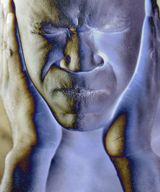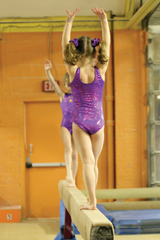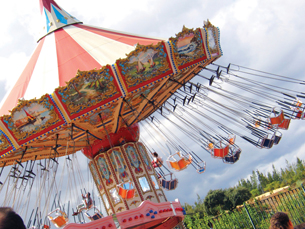Module 1
1. Module 1
1.41. Page 8
Module 1—The Nervous System
Homeostatic Imbalance in Hearing

© 2008 Jupiterimages Corporation
Healthcare professionals are very concerned that the present generation of young people will experience increased hearing loss as it ages. Deafness can be defined as one of two main types: conduction deafness or perception deafness.
deafness: any type of hearing loss, whether it is the inability to detect certain frequencies, the inability to detect very soft sounds, or the inability to detect any sound at all
conduction deafness: loss of hearing that results when the structures of the ear required to transmit and amplify vibrations (tympanum, ossicles, and oval window) are unable to do so; involves a malfunction in the conduction apparatus
perception (nerve) deafness: loss of hearing that results when the structures of the organ of Corti are unable to initiate nerve impulses
 Read
Read
From your reading of pages 423 and 424 and “Table 12.3,” make summary notes or a chart about the types and causes of deafness.
 Self-Check
Self-Check
SC 26. What is meant by the term deaf?
SC 27. State the parts of the ear that have been damaged or are non-functional in someone with
- perception (nerve) deafness
- conduction deafness
 Self-Check Answers
Self-Check Answers
SC 26. The term deaf refers to any type of hearing loss.
SC 27.
- In perception (nerve) deafness, any of the structures of the organ of Corti have been damaged, including the hair cells, the sensory neurons, the basilar membrane, the tectorial membrane, or the auditory nerve.
- In conduction deafness, structures such as the tympanum, any of the ossicles, or the connection between the stapes and the oval window may be damaged. In addition, things such as a buildup of wax in the auditory canal and against the tympanum can impede the conduction and amplification of sound in the inner ear.
Maintaining Balance
semicircular canals: three tubes that are situated at right angles to one another and contain mechanoreceptors that detect head and body rotation; responsible for dynamic balance or rotational equilibrium (rotational equilibrium dynamic balance), which is the balance that is established in response to the head and body being moved or rotated
utricle and saccule: tiny chambers in the inner ear that contain otoliths and hair cells, which respond to changes in head position with respect to gravity and movement in one direction; responsible for static balance or gravitational equilibrium
dynamic balance (rotational equilibrium): balance resulting when the head and body are moved or rotated
static balance (gravitational equilibrium): balance resulting from changes in the position or the movement of the head in one direction; usually in response to gravity
otolith: a tiny particle of calcium carbonate found in the utricle and saccule that contacts the hair cells of these structures and stimulates them
vestibule: the fluid-filled area of the inner ear located between the semicircular canals and the cochlea
The vestibule contains the utricle and saccule.
The ear has an important function in your ability to maintain balance. The inner ear has three additional structures known as the semicircular canals, the utricle, and the saccule that are responsible for maintaining balance.
When you twirl on the dance floor, spin in a rotating ride at the midway, or suffer through a rough boat ride, the semicircular canals are working overtime. This is called dynamic equilibrium or rotational equilibrium.
That queasy feeling you experienced when you pulled ahead of the truck slipping backwards on the icy hill and that feeling you get when a fast-moving elevator comes to an abrupt stop are the result of nerve impulses from the utricle and saccule. This is called static equilibrium or gravitational equilibrium. The utricle and saccule have otoliths, small granules of calcium carbonate that are pulled against the hair cells in the utricle and saccule when you move your head forwards or backwards. This mechanical stimulation starts a nerve impulse. Some impulses from the vestibule travel to the spinal cord, where body position can be adjusted by reflex action. Other impulses are sent to the cerebellum, where other reflexive muscular coordination occurs. Further impulses move to higher centres in the cerebrum involved in the control of eye movement. Input from the eyes is very important in maintaining balance. To show this, try closing your eyes and standing on one leg!
 Read
Read
At this point in your study of the ear, it is important to make sure that you include diagrams like the ones on pages 420 and 421 of your textbook. You may choose to combine the diagrams with a table listing the functions of each part that you have labelled. Save your work in your course folder.



left: © Robert J. Daveant/shutterstock; middle: © Melissa Schalke/shutterstock; right: © Carolina/shutterstock
To understand how the body maintains balance, choose one of the following two options. You may summarize the information in any format you choose and store this information in your course folder.
![]() Read pages 424 and 425 in the textbook.
Read pages 424 and 425 in the textbook.
OR
- “Balance”
- “Bio Review: Utricle and Saccule”
- “Dynamic Equilibrium”
- “Spins in Figure Skating”
 Self-Check
Self-Check
Test your understanding of the concepts by completing the following questions. Save your work in your course folder. If you do not understand a particular concept, consult your teacher.
SC 28. Describe the structures of the inner ear that are involved in maintaining balance.
SC 29. Explain how the structures of the inner ear allow for dynamic (rotational) equilibrium.
SC 30. Explain how static (gravitational) equilibrium is attained.
 Self-Check Answers
Self-Check Answers
SC 28. There are three structures of the inner ear involved in maintaining balance. These structures include the three fluid-filled semicircular canals situated at right angles to each other and, just below them, the fluid-filled utricle and saccule, which contain tiny rock-like granules of calcium carbonate called otoliths.
SC 29. The balance established while moving the head forward and backward is called dynamic (rotational) equilibrium. At the base of each of the semicircular canals is a jelly-like covering called a cupula. The tiny hairs of the hair cells in the semicircular canals, better known as stereocilia, stick into the cupula. When the body rotates, the fluid inside the semicircular canals moves and bends the stereocilia. The hair cells receive this information and send it to the brain.
SC 30. A person who is lying down or not moving is said to be in a static position. The movement, or lack of movement, of the fluid in the inner ear tells the brain whether a person is standing, lying down, hanging upside down, etc. When an individual is moving around, calcium carbonate crystals (otoliths) in the utricle and saccule shift position and contact the stereocilia of these structures. This contact results in nerve impulses being transmitted to the brain, indicating that the individual is changing positions. When the person is in an established position, the crystals stop rolling around. The sensory neurons in the vestibule of the utricle and saccule do not send any impulses to the brain, thereby indicating that the individual is in a static position once again.
 Try This
Try This
You will need somebody to help you with this exercise. A friend or a member of your family will do!
Step 1: Have your partner sit in a swivel chair with his or her head held in an upright position. Get your partner to raise his or her legs up off of the ground. Rotate the chair in a clockwise direction, but not too quickly. After 20 rotations, stop the chair and get your partner to stand. Be prepared to support or catch your partner! Make observations.
Step 2: Allow your partner to recover for about 5 minutes. Repeat the steps, but, this time, rotate the chair in a counterclockwise direction. Make sure your partner is holding his or her head straight. What did you observe this time?
Step 3: Allow your partner to recover for about 5 minutes.
Step 4: Have your partner sit in the swivel chair, but this time with his or her head tilted to the right. Rotate the chair clockwise 20 times. Ask your partner to stand and hold his or her head upright. What happens?
TR 8. What kind of evidence did you collect in your experiment that would suggest that the fluid in the semicircular canals continues to move even after you have stopped rotating the chair?
TR 9. Describe how the semicircular canals detect changes in motion during a rollercoaster ride.
TR 10. Are the utricle and saccule involved in maintaining balance during a rollercoaster ride?